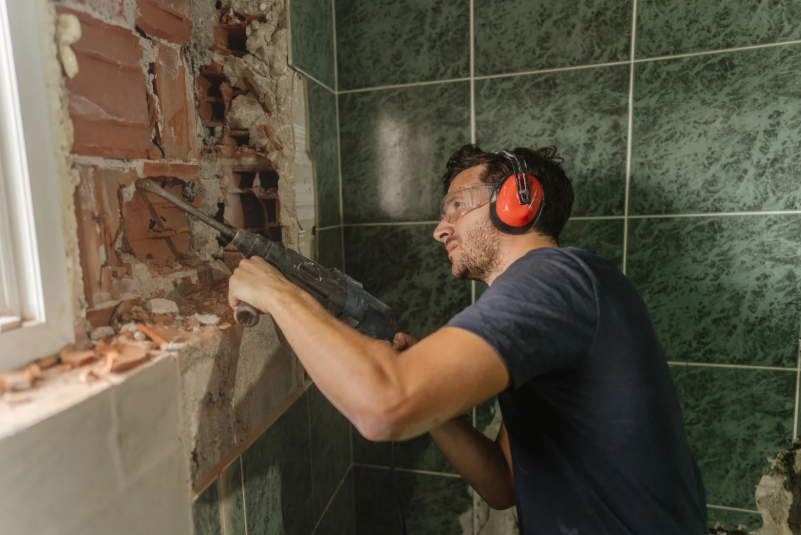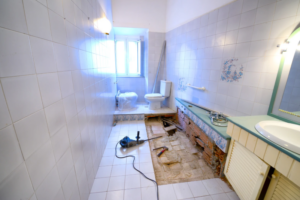
A renovation project begins not with hammers but with planning. One overlooked yet pivotal part of this process is choosing the right dumpster size, a decision that’s anything but trivial. The wrong size can bottleneck progress or bloat your budget, while the right one keeps the chaos neatly contained. From torn-up tiles to drywall debris, each renovation spews its own flavor of waste, making the container you choose more than just a metal box.
Different projects generate different amounts and types of refuse, and understanding volume isn’t always intuitive. A seemingly small bathroom gut might fill up faster than a garage overhaul. Consider the weight, the bulk, and even odd-shaped remnants before committing to a size that either overcompensates or underwhelms in capacity.
Perfect Dumpster Sizes for Bathroom Renovations
Renovating a bathroom may not seem like it would generate much debris, but you’d be surprised. Old toilets, bathtubs, vanities, and tile can pile up quickly, making waste management essential. For most bathroom remodels, a 10-yard dumpster offers the perfect balance between size and cost. It’s compact enough to fit in most urban driveways, yet spacious enough to handle the debris generated by a full bathroom overhaul.
You won’t have to worry about running out of room mid-project, which can be a major inconvenience. A 10-yard dumpster is like the Goldilocks of the renovation world—it’s just the right size for most standard bathroom renovations. However, if you’re renovating multiple bathrooms simultaneously or have a particularly large or complex project, it might be necessary to go for a slightly bigger container. Don’t forget that weight limits are also important to consider; broken tiles and heavy fixtures can quickly add up in weight.

Choosing the Right Container for Kitchen Makeovers
Kitchen renovations can get messy, and quickly. When you’re tearing out cabinets, countertops, and appliances, the debris can be bulky and hard to manage. For most kitchen remodels, a 15-yard dumpster is the ideal choice. This size provides ample space for larger items like old countertops and kitchen appliances, while still being manageable enough to fit in most residential areas. It strikes the perfect balance between size and efficiency.
Additionally, a 15-yard dumpster is small enough to prevent overfilling, which could lead to unnecessary pickups and higher costs. Kitchen projects also tend to generate a variety of waste materials—from wood to insulation to metal hardware—requiring flexibility in the size of the container. A 15-yard dumpster accommodates these diverse types of waste without the hassle of frequent hauling. This mid-sized bin is the workhorse of kitchen renovations, helping maintain a steady flow of work while keeping the site clean and organized.
Why 30-Yard Dumpsters Are Ideal for Major Renovation Projects
For major renovations or full-scale remodeling projects, you’ll need a dumpster that can handle the sheer volume of debris generated. That’s where the 30-yard dumpster comes in. This size is designed for large-scale projects like home renovations, demolition jobs, or tearing down structures like decks, fences, or sheds. With its substantial capacity, it can easily accommodate large items such as doors, beams, and furniture, along with the smaller debris created during the demolition process.
The 30-yard dumpster can hold around 12 pickup truckloads of waste, meaning you won’t have to worry about running out of space or scheduling multiple pickups. While it requires more room for placement and removal, the benefits far outweigh the drawbacks for large projects. Fewer pickups mean less disruption to your project’s schedule, keeping everything on track and running smoothly. Whether you’re overhauling an entire floor or knocking down a structure, the 30-yard dumpster ensures that all of your waste is managed efficiently and cost-effectively.
Factors That Influence Which Dumpster Size You’ll Need
Selecting the right dumpster size isn’t always as simple as just measuring your project’s square footage. While the size of the area you’re working on is certainly a factor, there are many other considerations that will impact your decision. One of the key factors is the type of materials you’re working with. For example, removing tile or concrete creates dense, heavy debris, while a kitchen remodel might generate more varied, but lighter waste. Since dumpsters have weight limits, it’s important to consider the weight of your materials in addition to their volume.
Some materials may take up less space but weigh a lot, pushing you over the weight limit and potentially resulting in extra fees. Another factor to keep in mind is the project’s timeline. Will your renovation be completed in a few days, or is it a longer-term endeavor? A short project may not need a large dumpster, but a longer one may require more frequent pickups. Space and access are also crucial considerations—if you’re working in a tight urban setting, your dumpster size might be limited by available space for placement. Always consider these variables before making a choice.
Dumpster Size Versus Weight Limit: How to Strike the Balance
When renting a dumpster, it’s easy to focus solely on the size of the container. However, weight limits are equally important and should never be overlooked. While a larger dumpster provides more volume, it doesn’t necessarily mean you can load it with heavy materials without incurring extra costs. Each dumpster comes with a specific weight limit, and exceeding that limit can result in hefty overage fees. For example, you could fill a 10-yard dumpster with lightweight materials and stay well within the weight limit, or you could fill the same size bin with heavy concrete or bricks, which could exceed the limit and cost more.
The key to selecting the right dumpster is finding the balance between size and weight capacity. When planning your project, consider the types of materials you’ll be throwing away and estimate their weight. This will help you choose the right size and avoid surprise charges. Properly estimating both volume and weight is the best way to keep your renovation on budget.
The Risks of Renting the Wrong Size Dumpster
Renting a dumpster that’s too small or too large for your project can cause a variety of problems. If the dumpster is too small, you may find yourself running out of room, which can disrupt your project’s timeline and lead to costly extra pickups. Overflowing dumpsters can be a hassle, and trying to squeeze more materials into a container that’s already full can result in fines or delays. On the other hand, renting a dumpster that’s too large may sound like a good idea to avoid the risk of running out of space, but it comes with its own set of issues.
Larger dumpsters come with higher rental costs, and you might end up paying for unused space. Additionally, they can be harder to maneuver or place in tight spaces, leading to additional logistical challenges. Too large a dumpster could also attract waste from neighbors or passersby, leaving you responsible for other people’s trash. In the end, renting the wrong size can add unnecessary stress, delays, and expense to your renovation.
Planning Dumpster Use Around Project Phases
Renovation projects are often divided into multiple phases, and it’s important to consider how your dumpster rental can align with each stage of the work. During the demolition phase, the amount of waste generated will be at its highest, and you’ll need a dumpster large enough to accommodate all of it. As the project moves into the construction or installation phase, the amount of debris might decrease, and you may need a smaller dumpster for light clean-up.
By planning your dumpster usage around each project phase, you can ensure that you’re not paying for space you don’t need during quieter periods. This approach also helps you avoid overfilling the dumpster during busy phases and ensures that your site stays organized and efficient. Consider working with your contractor to plan the optimal timing for dumpster rentals and pickups. By aligning your waste disposal strategy with the flow of the project, you can reduce costs and keep your work moving forward without unnecessary disruptions.
How Local Regulations Impact Dumpster Size Choices
Local regulations and restrictions can have a significant impact on the dumpster size you choose for your renovation project. In cities like Chicago, for example, there are strict rules about where and how dumpsters can be placed. Some neighborhoods have narrow alleys or tight street configurations that make it difficult to fit a large container. Additionally, some areas require permits for placing a dumpster on the street, and the size of the dumpster may affect whether or not you’re approved for a permit. In some cases, larger dumpsters may require additional clearance or restrictions on how long they can remain on public property.
It’s important to research local regulations before committing to a particular size to avoid delays or fines. If your project is in a dense, urban area, you may find that a smaller dumpster with more frequent pickups is more practical than a large dumpster that takes up too much space. By understanding your local rules, you can select the right dumpster size that keeps your project running smoothly and in compliance with local laws.
Conclusion
Selecting the right dumpster size for your renovation isn’t just a minor detail—it’s a critical decision that can make or break the momentum of your project. Whether you’re sprucing up a half-bath or gutting an entire home, choosing the correct dumpster ensures that waste management doesn’t become a bottleneck. A bin that’s too small can lead to frustrating delays and extra costs, while an oversized one may have you paying for space you don’t need.
Dumpster rental is about more than simply tossing debris—it’s about organizing the mess so you can stay focused on the transformation at hand. For expert guidance and reliable dumpster rental services in Chicago, reach out to 606 Junk Removal and Dumpster Rental at 773-412-4902 or email info@606junk.com. They’re local, professional, and ready to help your project run smoother.
